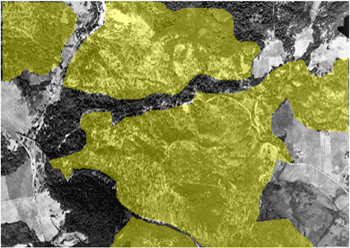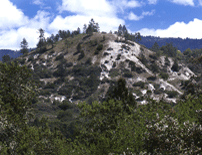
Habitat conversion has isolated and reduced the size of remaining Sandhills habitat patches. As illustrated in the aerial photographs of the central portion of the Sandhills distribution, near Felton, Mount Hermon, and Scotts Valley, Sandhills habitat occurred as several large patches as recently as 1943. By 2003, development and quarrying greatly reduced the Sandhills habitat area, such that only small, isolated patches remain.
The unnaturally small habitat patches cannot support populations of species which require larger, contiguous habitat areas, such as many mammal species. Roads, developments, and quarries can act as barriers to plant and animal dispersal, and preclude recolonization of habitat patches once extirpations (local extinctions) occur. Small, fragmented habitat patches are more susceptible to a variety of factors associated with the adjacent land use which degrade habitat conditions, including exotic plant and animal invasions and recreation. Due to the proximity of development, natural wildfires in the Sandhills must be suppressed, resulting in dense, senescent vegetation and closed canopy conditions which cannot support many sensitive plant and animal species, including the Santa Cruz kangaroo rat, Zayante Band-Winged Grasshopper, Ben Lomond spineflower, and Santa Cruz wallflower.


